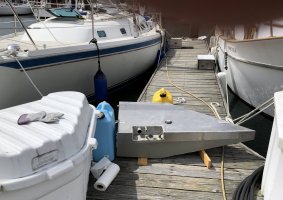Teranodon
Member III
A couple of weeks ago, I finally installed lazyjacks on my E34. I was very pleased with myself, and told my wife how happy I was with the boat: all systems were in excellent shape. It was a dumb thing to say. The following day I entered the cabin and smelled diesel fuel. I examined hoses, fittings, injectors, filters, etc., until the unpleasant truth could not be denied: the welded aluminum tank - only ten years old - was leaking. Feeling under the accessible part - the forward corner at the bottom of the tank - my fingers came away pink and wet. One drop every couple of minutes. Ugh!
Before anything else, I needed to get the fuel out, pronto. But how? I mentally cycled through various schemes for syphoning, buying a transfer pump, lifting the tank out “as is”, patching with special goop, etc. Since I am often a little slow on the uptake, it took some time before I hit on the obvious solution. The tank is already equipped with a pickup tube, and a hose that goes to the Racor filter, to the electric pump, and thence to the engine via a 3-foot rubber hose. So I removed a clamp, transferred the hose to the mouth of a yellow diesel can, and turned the ignition key. Two hours later, all of the fuel - some 15 gallons - was out. There followed a period of intense cursing and grunting to disconnect the tank, pry it out of its nest, and muscle it through the companionway. In a Covid-free world, two people could have done it in five minutes.
In my shop, I leveled the tank on sawhorses and let the residual fuel (plus a tell-tale sheet of toilet paper) show me the leak: a nearly invisible pinprick along the bottom edge.
The normally-friendly local welder was not happy to see me. I guess he didn’t feel like blowing himself up. Wanted me to flush the tank with transmission fluid (huh?) in a complicated way, but finally relented and told me to just bring it over and leave the whole thing to him. He did a very nice job.

 Ten days after discovering the leak, and $100 poorer, I have my boat back. I’m really happy with it now. All systems are in excellent shape!
Ten days after discovering the leak, and $100 poorer, I have my boat back. I’m really happy with it now. All systems are in excellent shape!
Before anything else, I needed to get the fuel out, pronto. But how? I mentally cycled through various schemes for syphoning, buying a transfer pump, lifting the tank out “as is”, patching with special goop, etc. Since I am often a little slow on the uptake, it took some time before I hit on the obvious solution. The tank is already equipped with a pickup tube, and a hose that goes to the Racor filter, to the electric pump, and thence to the engine via a 3-foot rubber hose. So I removed a clamp, transferred the hose to the mouth of a yellow diesel can, and turned the ignition key. Two hours later, all of the fuel - some 15 gallons - was out. There followed a period of intense cursing and grunting to disconnect the tank, pry it out of its nest, and muscle it through the companionway. In a Covid-free world, two people could have done it in five minutes.
In my shop, I leveled the tank on sawhorses and let the residual fuel (plus a tell-tale sheet of toilet paper) show me the leak: a nearly invisible pinprick along the bottom edge.
The normally-friendly local welder was not happy to see me. I guess he didn’t feel like blowing himself up. Wanted me to flush the tank with transmission fluid (huh?) in a complicated way, but finally relented and told me to just bring it over and leave the whole thing to him. He did a very nice job.

 Ten days after discovering the leak, and $100 poorer, I have my boat back. I’m really happy with it now. All systems are in excellent shape!
Ten days after discovering the leak, and $100 poorer, I have my boat back. I’m really happy with it now. All systems are in excellent shape!
